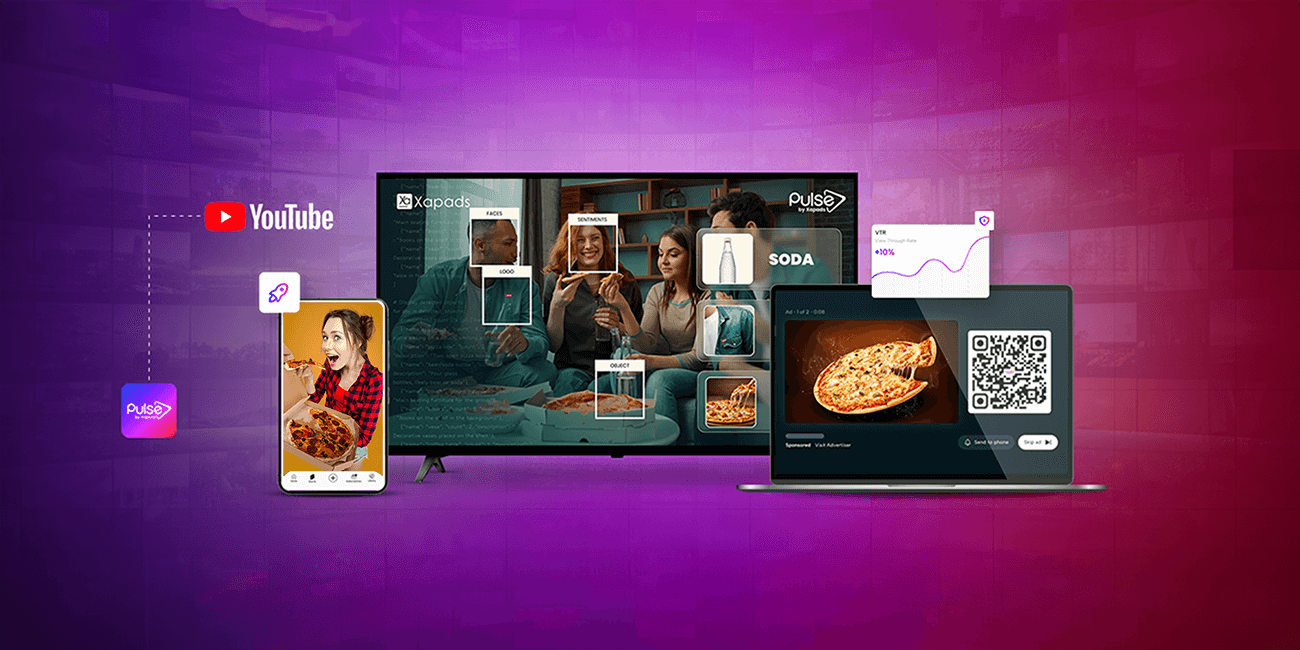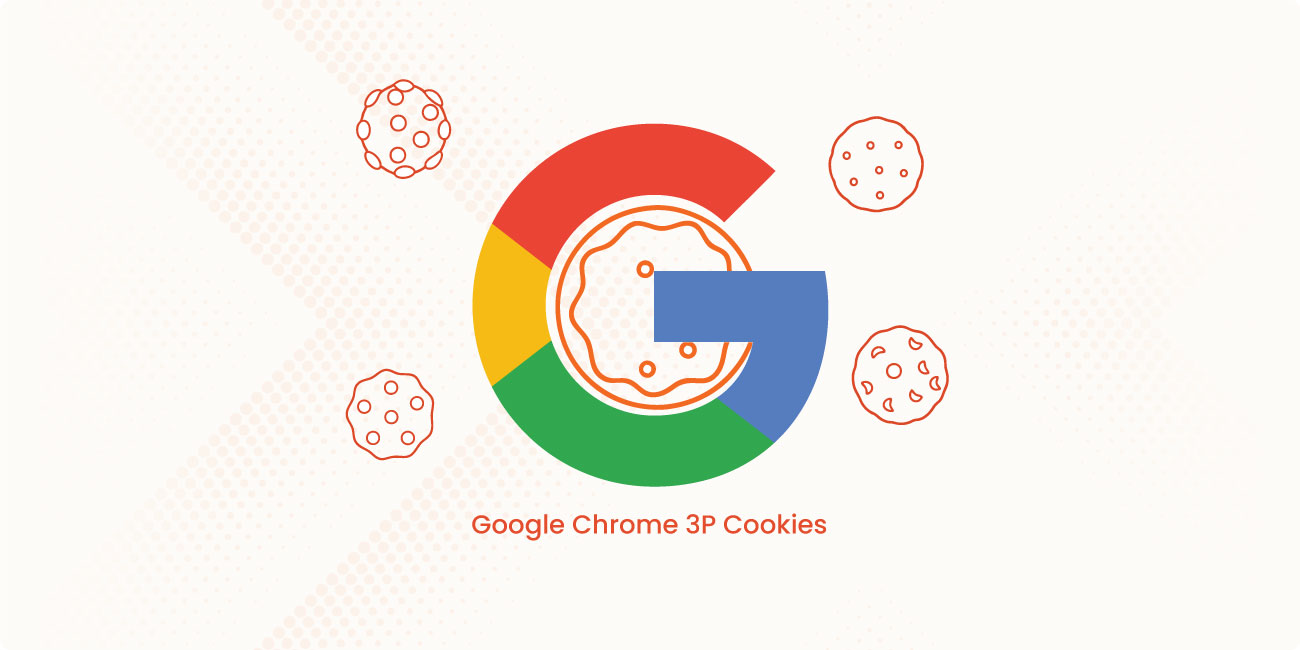
The digital advertising landscape moves at a breakneck speed, but few technologies have transformed it as dramatically as Real Time Bidding (RTB). In my 18 years in this industry, including 15+ years at Xapads Media, I’ve watched RTB evolve from an experimental concept to the engine powering over $500 billion in global digital ad spend.
Today, RTB can process billions of transactions every second, yet most marketers still struggle to harness its full potential. This guide cuts through the complexity to deliver practical, actionable strategies that actually work in 2025’s privacy-first ecosystem.
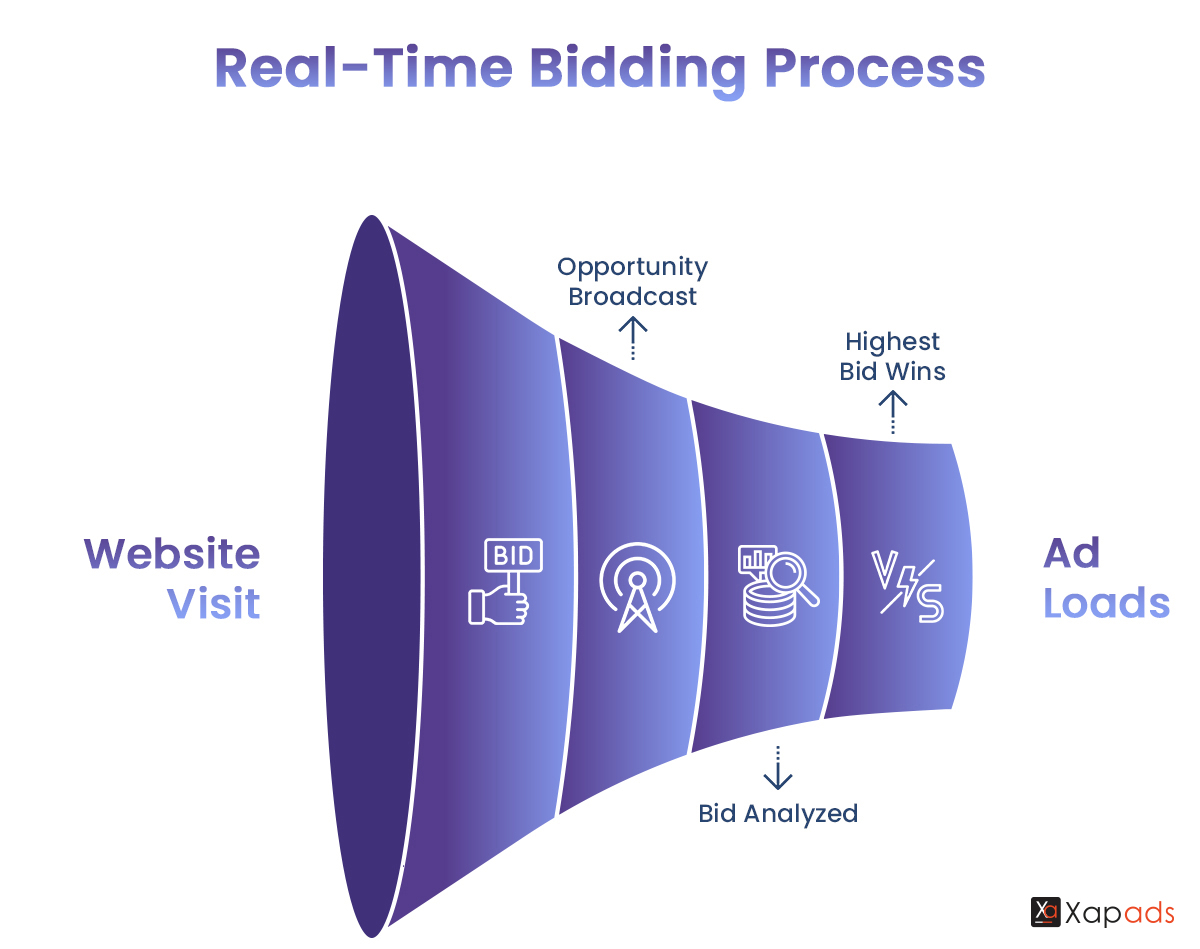
The Evolution of RTB: From Cookies to Context
Real Time Bidding has undergone a radical transformation since its inception. When I started at Xapads, third-party cookies were the gold standard for targeting. Now, we’re navigating a cookieless world where context and first-party data reign supreme.
The shift hasn’t been easy. Chrome’s Privacy Sandbox rollout in early 2024 forced the entire industry to reimagine how RTB works. Instead of tracking individual users across sites, we now use aggregated signals and contextual cues to make bidding decisions in those crucial 100 milliseconds.
vRTB vs Traditional Advertising: A Data-Driven Comparison
Let me share some real numbers from our Xapads exchange. Traditional display advertising typically sees CPMs ranging from $2-5 with click-through rates around 0.05%. Compare that to our RTB campaigns, which average $0.50-2 CPMs with CTRs of 0.15-0.25% – that’s a 3x improvement in engagement at half the cost.
The efficiency gains extend beyond cost. Traditional campaigns take days or weeks to launch and optimize. RTB campaigns go live in minutes and self-optimize in real-time based on performance data.
The 100-Millisecond Symphony: How RTB Actually Works
Think of RTB like a lightning-fast auction house where thousands of buyers compete for your attention in the time it takes to blink. Here’s the simplified flow:
- You visit a website
- The publisher sends a bid request to their SSP (Supply-Side Platform)
- The SSP broadcasts this opportunity to multiple DSPs (Demand-Side Platforms)
- DSPs analyze the opportunity and submit bids
- The highest bidder wins and their ad loads
All of this happens in under 100 milliseconds. At Xapads, we process over 10 billion of these auctions daily, each one a complex decision involving user context, campaign goals, and budget constraints.
Key Players in the RTB Ecosystem 2025
The RTB landscape has expanded beyond traditional DSPs and SSPs. Today’s ecosystem includes:
- Clean rooms for secure data collaboration
- Identity providers offering cookieless solutions
- Verification partners ensuring brand safety
- Sustainability auditors measuring carbon impact
This complexity requires careful partner selection. I’ve seen advertisers waste millions by choosing the wrong mix of platforms.
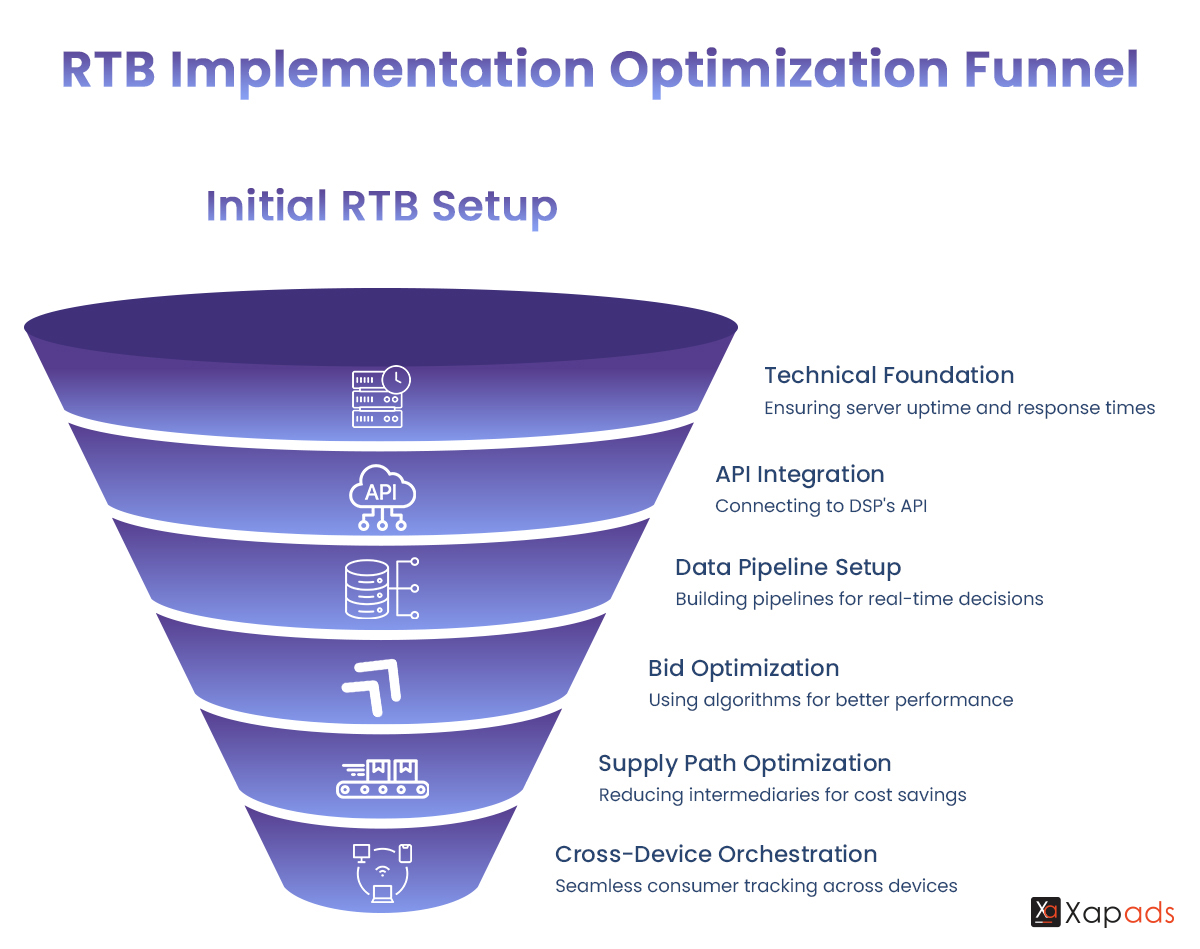
Advanced RTB Implementation Strategies
Building Your RTB Infrastructure: A Step-by-Step Guide
Setting up RTB infrastructure isn’t plug-and-play. Here’s the framework we use at Xapads:
Step 1: Technical Foundation Ensure your servers can handle high-frequency requests. You’ll need at least 99.9% uptime and sub-50ms response times. Cloud providers like AWS or Google Cloud offer the scalability you need.
Step 2: API Integration Connect to your chosen DSP’s API. Most modern platforms use OpenRTB 3.0 protocol. Test thoroughly – a misconfigured integration can burn through budgets fast.
Step 3: Data Pipeline Setup Build robust data pipelines for real-time bidding decisions. This includes user data, contextual signals, and campaign parameters.
Warning Box: Never skip the testing phase. I’ve seen companies lose $100,000+ in hours due to improper QA.
Bid Optimization Algorithms That Actually Work
Machine learning has revolutionized bid optimization. At Xapads, our proprietary algorithm considers over 50 variables in milliseconds:
- Historical performance data
- Time of day patterns
- Device and browser combinations
- Contextual relevance scores
- Competitive landscape analysis
The result? Our DSP clients see 47% better performance compared to manual bidding strategies. The key is starting with clear KPIs and letting the algorithm learn from actual campaign data.
Supply Path Optimization (SPO) in Practice
SPO remains one of the most underutilized strategies in RTB. By cutting out unnecessary intermediaries, we’ve helped clients reduce programmatic costs by 35% while improving transparency.
Here’s a practical approach:
- Audit your current supply paths
- Identify direct publisher relationships
- Eliminate redundant intermediaries
- Monitor performance improvements
One client reduced their supply chain from 6-5 hops to 2-1, saving $2 million annually while improving viewability by 22%.
Cross-Device and Cross-Channel RTB Orchestration
Modern consumers jump between devices constantly. Effective RTB must follow them seamlessly. We use deterministic matching where possible and probabilistic modeling to fill gaps.
The challenge? Maintaining accuracy while respecting privacy. Unified ID 2.0 shows promise, with adoption reaching 60% of major publishers. However, no single solution works everywhere – you need a portfolio approach.
Privacy-First RTB: Navigating the Cookieless Future
Chrome Privacy Sandbox Integration Guide
Google’s Privacy Sandbox fundamentally changes how RTB works. Instead of tracking individuals, we now bid on interest groups and topics. Here’s what’s working:
Topics API provides broad interest categories without exposing individual browsing history. It’s less precise than cookies but surprisingly effective for upper-funnel campaigns.
Protected Audience API (formerly FLEDGE) enables remarketing without third-party cookies. Implementation is complex, but early adopters see 70-80% of cookie-based remarketing performance.
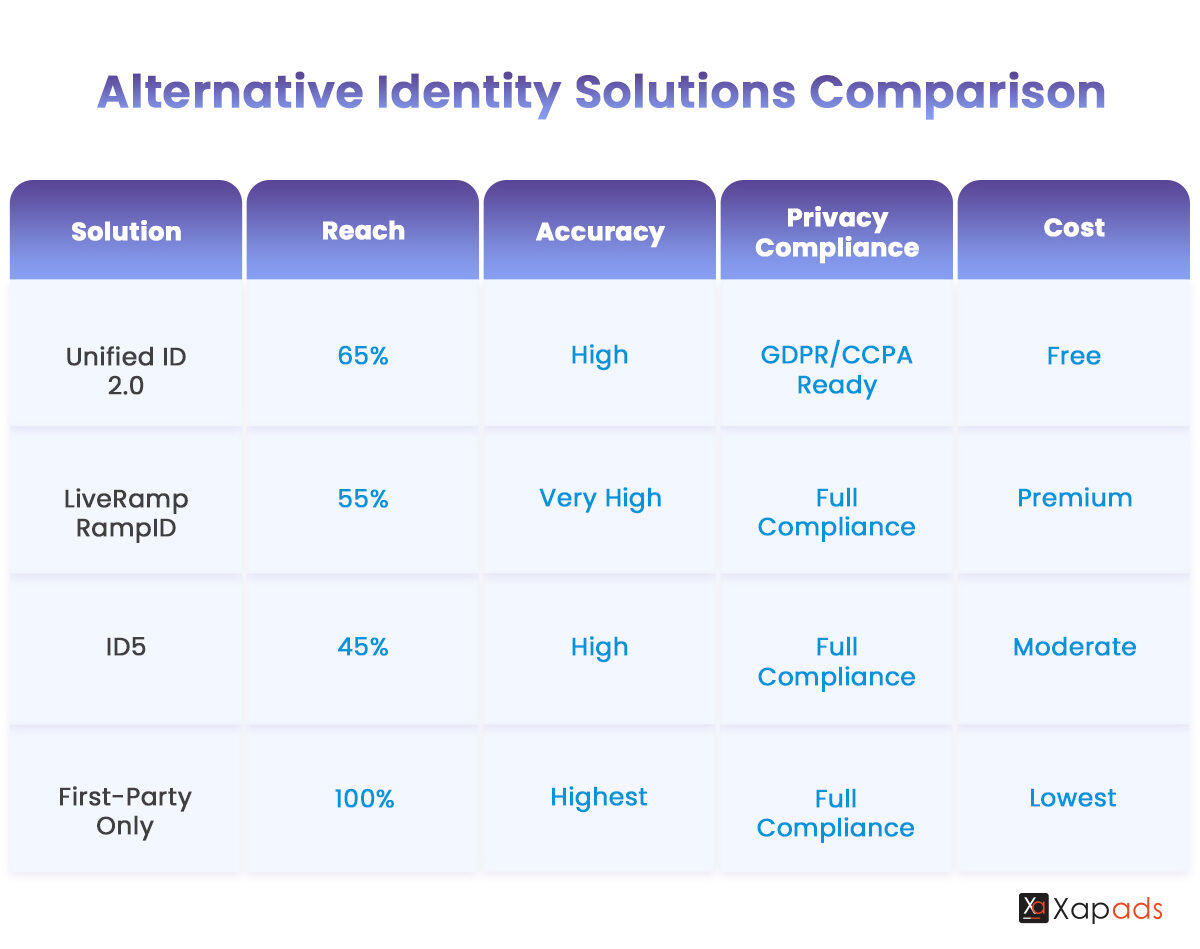
Each solution has trade-offs. We typically recommend a hybrid approach, using first-party data as the foundation and layering in alternative IDs for scale.
Compliance Framework for Global RTB Operations
Privacy regulations multiply monthly. GDPR, CCPA, LGPD, PIPEDA – the acronym soup can overwhelm. Here’s our simplified compliance framework:
- Consent First: Never bid on users without proper consent
- Data Minimization: Collect only what you need
- Transparency: Clearly explain data usage
- User Control: Enable easy opt-outs
Non-compliance isn’t just about fines (though those can reach 4% of global revenue). It’s about trust. One privacy scandal can destroy years of brand building.
Building Privacy-Safe Audience Segments
Cohort-based targeting represents the future of RTB. Instead of targeting individuals, we group users with similar interests while maintaining anonymity. Google’s Topics API provides 350+ interest categories, sufficient for most campaigns.
For more precision, consider contextual targeting’s renaissance. Modern contextual solutions use AI to understand page content at a granular level, often outperforming behavioral targeting.
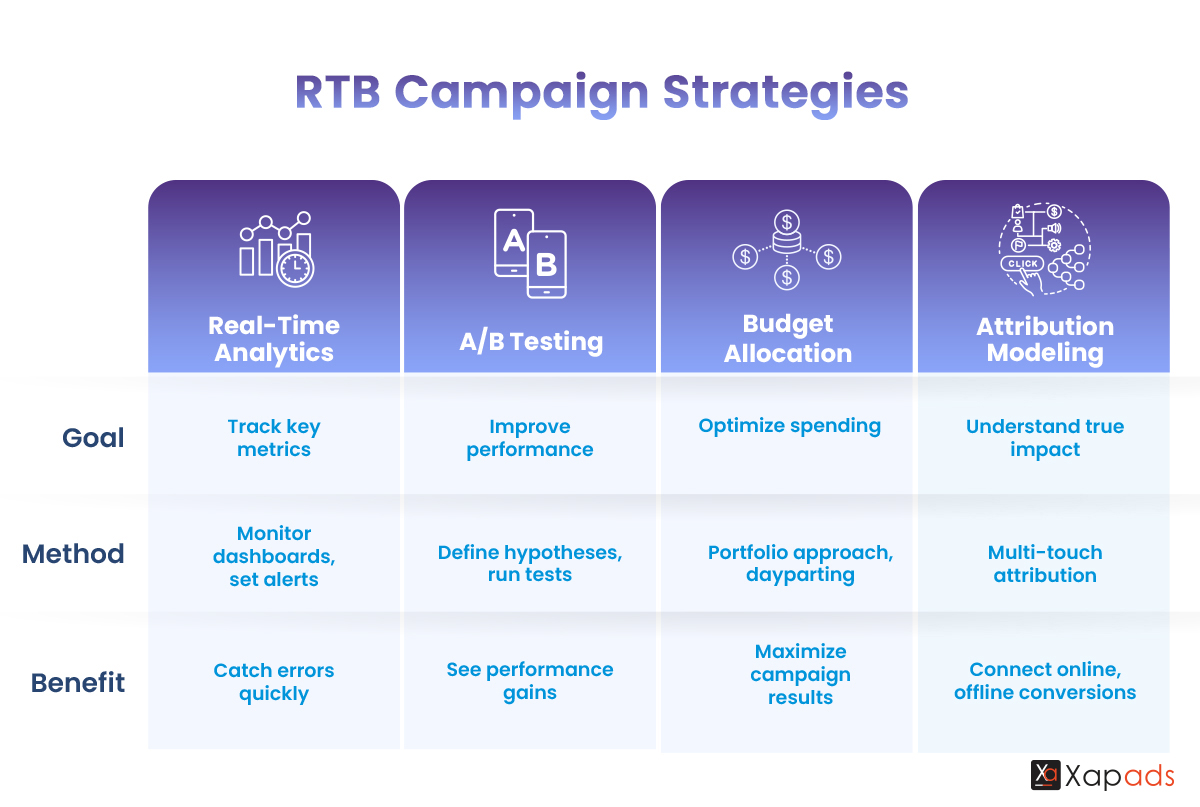
RTB Performance Optimization and ROI Maximization
Real-Time Analytics and Monitoring
You can’t optimize what you don’t measure. Our RTB dashboard tracks:
- Bid win rate by exchange
- Effective CPM trends
- Viewability scores
- Conversion attribution
- Fraud detection alerts
Set up automated alerts for anomalies. When bid prices spike 20% above normal, you need to know immediately. These systems saved one client $50,000 by catching a configuration error within minutes.
A/B Testing Framework for RTB Campaigns
Testing in RTB requires statistical rigor. With billions of impressions, even tiny improvements compound dramatically. Our framework:
- Define Clear Hypotheses: “Increasing bid 10% on mobile will improve conversion rate”
- Calculate Sample Size: Use statistical calculators to ensure significance
- Run Clean Tests: Control for external variables
- Document Results: Build an optimization knowledge base
We typically see 15-20% performance improvements through systematic testing. The key is patience – don’t call tests too early.
Budget Allocation Models That Drive Results
Smart budget allocation separates successful RTB campaigns from money pits. We use a portfolio approach:
- 60% on proven strategies
- 30% on emerging opportunities
- 10% on experimental tactics
Within each bucket, apply dayparting based on performance data. Our analysis shows B2B campaigns perform 40% better during business hours, while e-commerce peaks evenings and weekends.
Attribution Modeling for RTB Success
Last-click attribution is dead. Modern RTB requires sophisticated multi-touch attribution to understand true impact. We implement:
- Linear attribution for awareness campaigns
- Time-decay models for consideration strategies
- Data-driven attribution for performance campaigns
The challenge? Connecting online RTB impressions to offline conversions. Solutions like LiveRamp’s offline conversion tracking help bridge this gap.
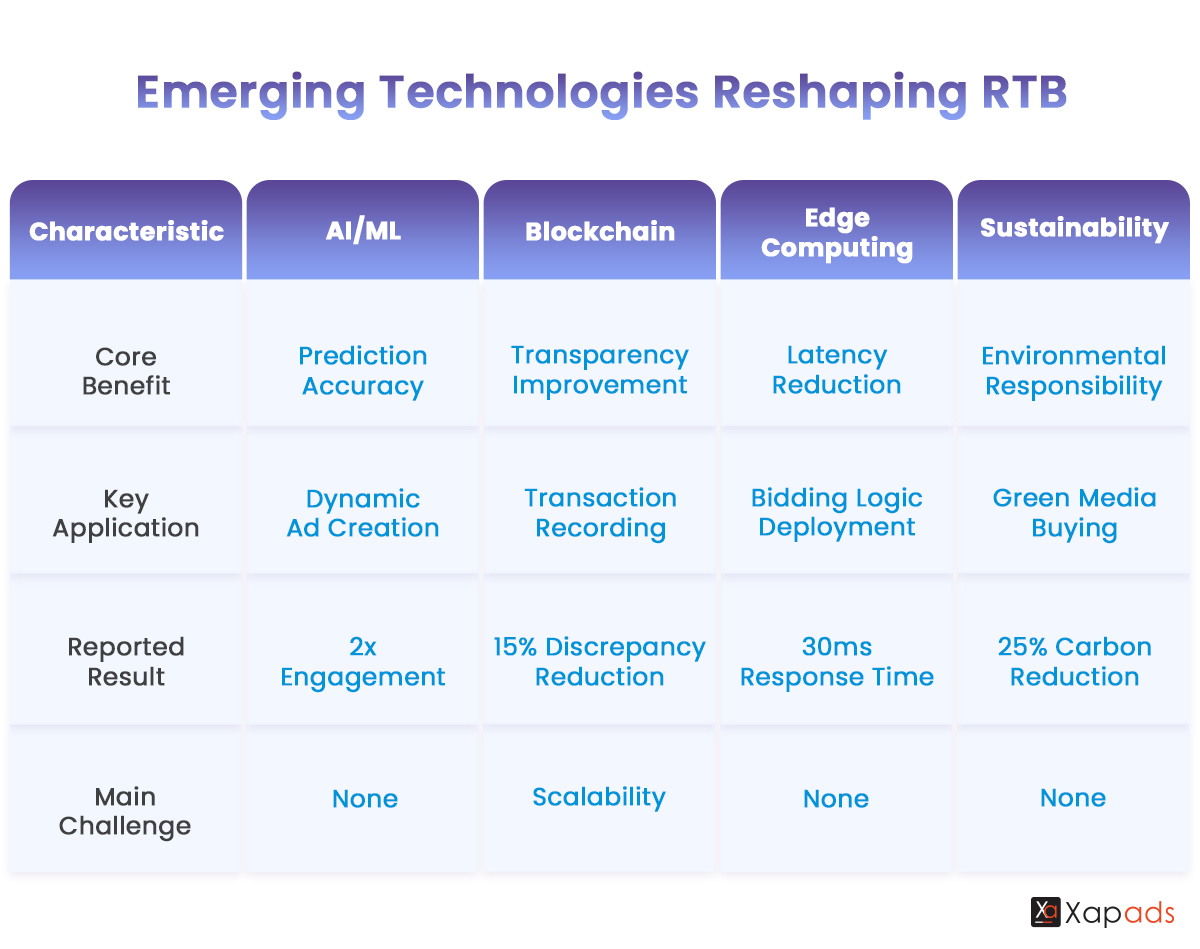
Emerging Technologies Reshaping RTB
AI and Machine Learning in Modern RTB
AI isn’t just buzzword – it’s fundamental to modern RTB. Our ML models predict:
- Optimal bid prices with 85% accuracy
- Conversion probability by user segment
- Creative performance before launch
- Fraud likelihood in real-time
The latest development? Generative AI creating dynamic ad creative based on context. Early tests show 2x engagement rates compared to static creative.
Blockchain and Transparency in RTB
Blockchain promises to solve RTB’s transparency problem. By recording every transaction immutably, it eliminates discrepancies between buyer and seller reports.
We’re testing blockchain integration for high-value campaigns. Initial results show 15% reduction in discrepancies and faster payment reconciliation. However, scalability remains challenging – blockchain can’t yet handle RTB’s volume.
Edge Computing and RTB Latency Reduction
Edge computing brings processing closer to users, reducing latency dramatically. By deploying bidding logic at edge locations, we’ve cut response times from 80ms to 30ms.
This matters because every millisecond counts. Publishers timeout slow bidders, meaning you miss opportunities. Edge computing ensures you’re always in the auction.
Sustainability in Programmatic Advertising
The advertising industry generates massive carbon emissions through data processing. Forward-thinking brands now consider environmental impact alongside performance metrics.
We’ve implemented green media buying practices:
- Choosing renewable-powered data centers
- Optimizing for fewer bid requests
- Supporting publishers with sustainability commitments
Result? 25% reduction in carbon footprint with no performance impact.
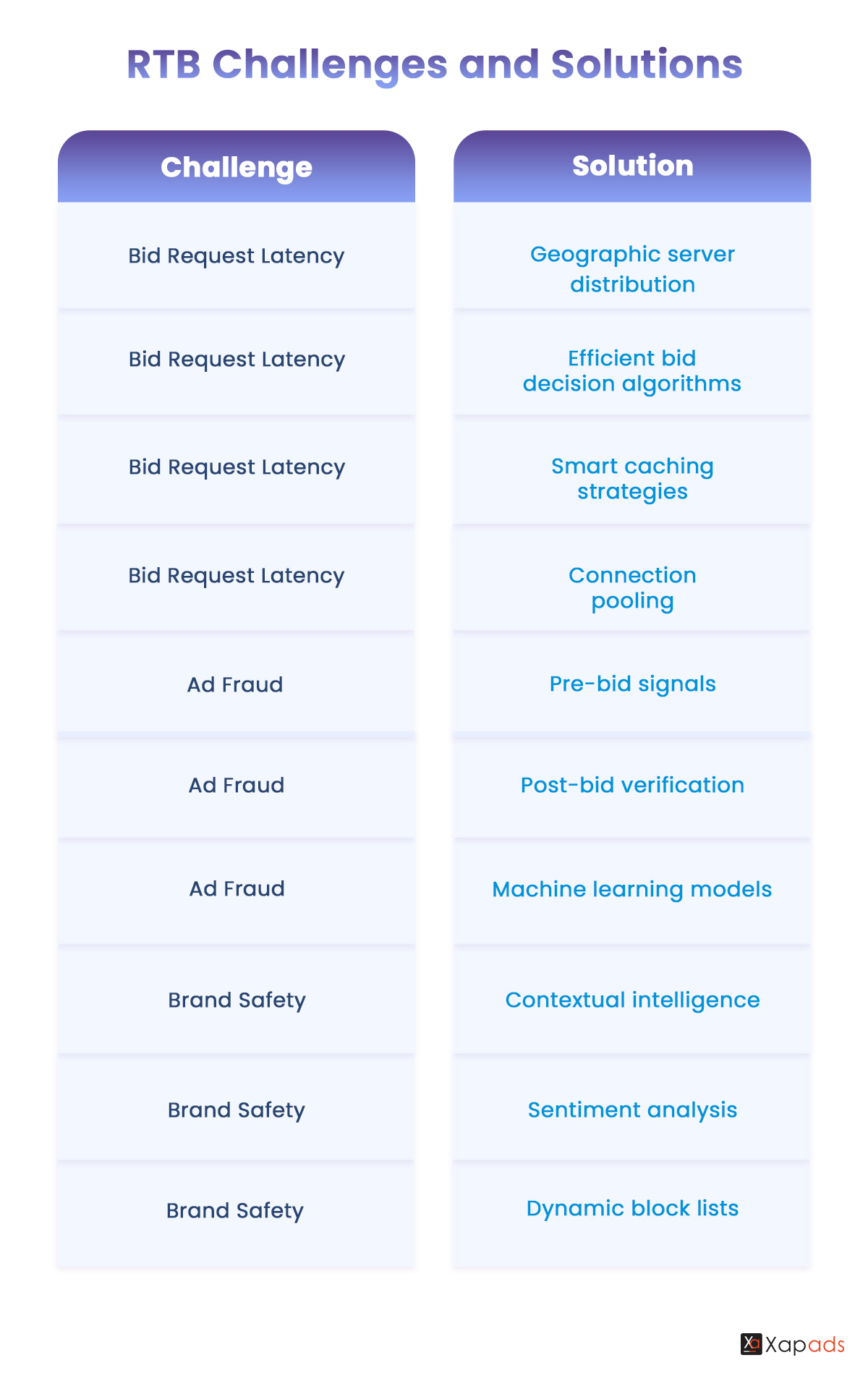
Common RTB Challenges and Solutions
Addressing Bid Request Latency Issues
Latency kills RTB performance. If you can’t respond in 100ms, you’re out. Here’s our optimization checklist:
- Geographic server distribution (reduce physical distance)
- Efficient bid decision algorithms (optimize code)
- Smart caching strategies (pre-compute when possible)
- Connection pooling (reuse network connections)
One client reduced latency by 60% just by moving servers closer to major exchanges.
Combating Ad Fraud in RTB
Ad fraud costs the industry $100+ billion annually. At Xapads, we’ve reduced fraud by 78% through multi-layered defense:
Pre-bid signals identify suspicious inventory before bidding. Look for:
- Abnormal traffic patterns
- Known fraudulent domains
- Impossible user behaviors
Post-bid verification confirms legitimate delivery. Partner with verification providers like IAS or DoubleVerify for independent validation.
Machine learning models detect emerging fraud patterns. Fraudsters constantly evolve tactics – your defenses must too.
Managing Brand Safety in Programmatic
Brand safety isn’t optional. One misplaced ad can trigger PR nightmares. Modern solutions go beyond simple keyword blocking:
- Contextual intelligence understands content meaning
- Sentiment analysis avoids negative contexts
- Dynamic block lists update in real-time
We recommend inclusion lists over exclusion. Define where you want to appear rather than endless lists of where you don’t.
Leading Companies in the RTB Ecosystem
The Powerhouses Shaping Real Time Bidding
The RTB landscape features several dominant players, each bringing unique strengths to the ecosystem. Understanding these key players helps you make informed partnership decisions.
Google (DV360 & AdX) Google dominates both buy and sell sides with Display & Video 360 (DV360) and Google Ad Exchange (AdX). They process over 50% of global RTB transactions, offering unmatched scale and integration with Google’s ecosystem. Their strength lies in data signals from Search, YouTube, and Chrome, though privacy changes are forcing evolution.
Amazon DSP Amazon leverages unparalleled purchase intent data, making them formidable in e-commerce RTB. Their closed-loop attribution – seeing from ad exposure to purchase – provides insights other platforms can’t match. They’re expanding aggressively beyond retail into broader programmatic markets.
The Trade Desk The largest independent DSP, The Trade Desk champions the open internet. Their Unified ID 2.0 initiative leads the cookieless transition, while their platform excels at cross-channel orchestration. They process over $9 billion in annual ad spend without owning media, maintaining true neutrality.
Xapads Media As a specialized programmatic ad exchange, Xapads Media stands out through integrated solutions spanning self-serve monetization, RTB, Performance DSP, CTV, and OEM partnerships. Processing over 10 billion daily bid requests, we focus on emerging markets and innovative formats. Our strength lies in combining exchange operations with demand-side capabilities, offering advertisers direct access to premium inventory while maintaining transparency.
What sets Xapads apart is our hybrid approach – we’re not just a technology platform but a strategic partner. Our 15+ years of experience translate into better optimization algorithms and deeper market insights, particularly in mobile and app monetization.
AppLovin AppLovin dominates mobile app RTB, leveraging their game portfolio for unique data insights. Their MAX mediation platform and AppDiscovery network create a powerful ecosystem for app developers. They’ve expanded into e-commerce and CTV, challenging established players.
Magnite (formerly Rubicon Project + Telaria) The largest independent SSP, Magnite focuses on premium publishers and CTV inventory. Their server-side solutions reduce latency while their transparency initiatives set industry standards. The merger created scale to compete with walled gardens.
PubMatic Another major independent SSP, PubMatic differentiates through infrastructure ownership. Their global data centers provide edge computing advantages, reducing latency and costs. They’re pioneering supply path optimization and sustainability initiatives.
Adobe Advertising Cloud Adobe leverages their Creative Cloud and Experience Cloud integration for unique RTB capabilities. Their strength lies in connecting creative production with programmatic distribution, enabling dynamic creative optimization at scale.
Choosing the Right RTB Partner
When selecting RTB partners, consider:
Scale vs. Specialization: Giants like Google offer reach but less flexibility. Specialized platforms like Xapads provide customization and direct support.
Data Capabilities: Evaluate first-party data assets and identity solutions. Post-cookie success depends on data strategy.
Geographic Presence: Global platforms may lack local market expertise. Regional specialists often deliver better performance in specific markets.
Technology Stack: Modern infrastructure matters. Look for edge computing, AI capabilities, and privacy-first architecture.
Transparency Level: Independent platforms typically offer more transparency than walled gardens. Understand fee structures and data access.
Innovation Pace: The RTB landscape evolves rapidly. Partners investing in R&D and new formats position you for future success.
At Xapads, we’ve built our platform recognizing that one size doesn’t fit all. While Google and Amazon excel at scale, we focus on flexibility, transparency, and emerging opportunities like CTV and OEM partnerships. This specialized approach helps our clients find untapped inventory and achieve superior ROI.
The Future of RTB: 2025-2030 Predictions
Privacy-Preserving Technologies
The next five years will revolutionize how RTB handles data. Technologies like secure multi-party computation enable targeting without exposing individual data. Imagine running campaigns where no single party – not even the DSP – sees user-level information.
Federated learning takes this further, training AI models across distributed data without centralization. Early experiments show 90% of centralized model performance while maintaining complete privacy.
New Formats and Channels
RTB expands beyond traditional display into:
- Metaverse placements: Virtual billboards in gaming environments
- Voice-activated ads: Programmatic audio responding to smart speakers
- AR overlays: Real-time bidding for augmented reality experiences
At Xapads, we’re already testing metaverse RTB with major gaming platforms. Early CPMs are high, but engagement rates are extraordinary.
Market Consolidation and Innovation
I predict significant consolidation ahead. Smaller players can’t afford the infrastructure and compliance costs. Expect major acquisitions as larger platforms seek specialized capabilities.
Simultaneously, innovation accelerates. Quantum computing promises to revolutionize bid optimization, potentially analyzing millions of variables simultaneously. While still experimental, forward-thinking companies should start preparing now.
Practical RTB Implementation Checklist
Before launching your RTB campaigns, ensure:
Technical Readiness:
- Server infrastructure handles the required QPS
- API integrations thoroughly tested
- Monitoring systems operational
- Backup systems configured
Legal Compliance:
- Privacy policies updated
- Consent mechanisms implemented
- Data retention policies defined
- Vendor agreements reviewed
Team Preparation:
- Roles clearly defined
- Training completed
- Escalation procedures documented
- Success metrics agreed
Real-time bidding transformed digital advertising and continues evolving rapidly. Success requires balancing performance with privacy, efficiency with brand safety, and automation with human oversight.
Start with solid infrastructure, embrace privacy-first strategies, and continuously test and optimize. The companies winning at RTB treat it as a core competency, not just another channel.
Remember: RTB is powerful but complex. Invest in expertise, whether building internal teams or partnering with experienced platforms. The payoff – better performance at lower costs – justifies the effort.
FAQs About Real-Time Bidding
What’s the minimum budget needed for effective RTB?
While RTB works at any scale, I recommend starting with at least $10,000 monthly. This provides sufficient data for optimization while limiting risk. Below this threshold, you won’t generate statistically significant results for testing.
How does RTB work without third-party cookies?
Modern RTB uses multiple signals: first-party data, contextual information, and privacy-safe identifiers like Topics API. While individual targeting precision decreases, aggregate performance often matches or exceeds cookie-based campaigns through better creative and context matching.
Should I use first-price or second-price auctions?
First-price auctions now dominate, representing 90% of inventory. They’re more transparent but require sophisticated bid shading algorithms to avoid overpaying. Without proper optimization, you’ll pay 20-30% more than necessary.
How do I measure incremental lift from RTB campaigns?
Implement holdout testing where a control group doesn’t see your ads. Compare conversion rates between exposed and unexposed groups. For accuracy, ensure groups are randomly selected and statistically significant. Most platforms offer built-in incrementality testing tools.
Will RTB still exist in 2030?
Absolutely, but it will look different. Expect more privacy protection, AI-driven optimization, and new channels like AR/VR. The core concept – real-time auctions for ad inventory – remains valuable. Companies investing in RTB capabilities now will lead tomorrow’s market.

